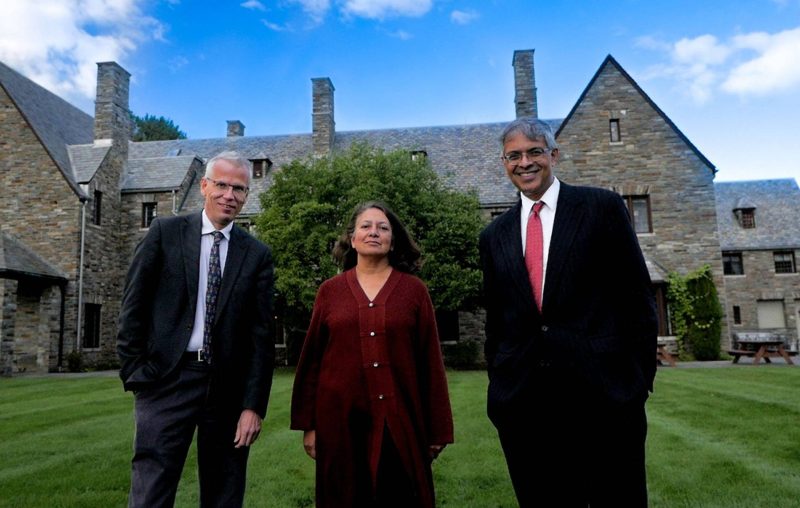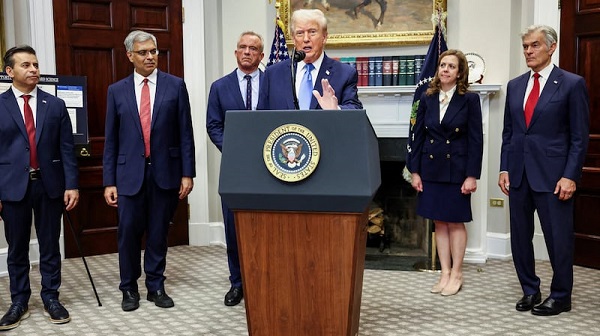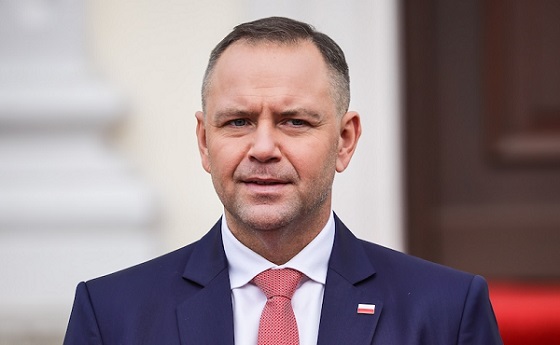Brownstone Institute
The Declaration That Wasn’t Supposed to Happen

From the Brownstone Institute
BY
It’s been a continuing mystery for three years, at least to me but many others too. In October 2020, in the midst of a genuine crisis, three scientists made a very short statement of highly public health wisdom, a summary of what everyone in the profession, apart from a few oddballs, believed only a year earlier. The astonishing frenzy of denunciation following that document’s release was on a level I’ve never seen before, reaching to the highest levels of government and flowing through the whole of media and tech. It was mind-boggling.
For proof that nothing in the document was particularly radical, look no further than the March 2, 2020, letter from Yale University signed by 800 top professionals. It warned against quarantines, lockdowns, closures, and travel restrictions. It said such extreme measures “can undermine public trust, have large societal costs and, importantly, disproportionately affect the most vulnerable segments in our communities.” That document appeared only two weeks before the lockdowns announced by the Trump administration.
That was the period of the grant amnesia. The conventional wisdom turned on a dime toward full backing of regime priorities, a shift more extreme and mind boggling that anything in dystopian fiction.
Seven months later, the Great Barrington Declaration said something very similar to the Yale document. It was a summary statement concerning what governments and society should and should not do during pandemics. They should seek to allow everyone to live as normally as possible in order to avoid guaranteed damage from coerced disruptions. And the vulnerable population – those who would experience medically significant impacts from exposure – should be protected from exposure insofar as doing so is consistent with human rights and choice.
It was nothing particularly novel, much less radical. Indeed, it was accepted wisdom the year before and for the previous century. The difference this time, however, is that the statement was released during the wildest and most destructive science experiment in modern times. The existing policy of lockdowns was utter wreckage: of businesses, schools, churches, civic life, and freedom itself. Masks were being forced on the whole population, including children. Governments were attempting a regime of test, track, trace, and isolate, as if there were ever any hope of containing a respiratory pathogen with a zoonotic reservoir.
The carnage was everywhere already and obvious from a look at every downtown of every city in the US. Stores were boarded up. The streets were mostly empty. The professional class was hunkered down, binging on streaming and gaming services, while the working class was hustling everywhere to deliver groceries to doorsteps. In short, insanity had broken out.
Several groups of doctors had already made strong statements against the goings on, including the frontline doctors group on Capitol Hill and the brilliant Bakersfield doctors, among many individuals. However, they were quickly shot down by major media and blasted for failing to support the great undertaking. Even that was astonishing to watch unfold. It didn’t matter how exalted the reputations of the doctors or scientists were. They were all shot down, more or less instantly, as crazies and cranks.
It was like living in a horror house of mirrors where nothing appears as it is supposed to. At the time, I chalked it all up to mass confusion, cultural amnesia, bad education, government overreach, media ignorance, or just some general tendency of humanity to go mad that I had not previously seen in my lifetime but had only known from history books.
Several top epidemiologists felt the same way. They were Martin Kulldorff from Harvard, Jay Bhattacharya from Stanford, and Sunetra Gupta from Oxford. Together they wrote a very short statement in hopes of bringing public officials and common people back to good sense and rationality. We had the idea of putting it online and inviting others to sign. We were racing against time because there were several interviews coming up. Lucio Saverio-Eastman, now with Brownstone, skipped a nights’ sleep to create the website. He tells the story here.
The blowback began within hours. It was really something to behold. Twitter accounts came out of nowhere to smear the document and its producers and the institution that hosted the event where the scientists explained their thinking. The calumnies and attacks were coming in so quickly that it was impossible to respond. The website itself was subject to open and admitted sabotage, with fake names. That required some fast patches and new levels of security.
It was a storm of frenzy the likes of which I had never seen. It’s one thing to object to a point of view but this was next-level. The hit pieces were pouring out of huge venues, almost as if they had been ordered from the top. Much later we found out that they had in fact been ordered: Francis Collins, the head of National Institutes of Health, called for a “quick and devastating takedown” of the document.
When that revelation came out, it didn’t make much sense to me. I get that this view had become what seemed to be a minority view but how do you “take down” the public health wisdom of one hundred years? The GBD was not the outlying position; the lockdowns were the radical move that never had a scientific justification. They were just imposed as if they were normal even though everyone knew they were not.
Lately we’ve been flooded with more information that starts to make sense of this puzzle. As Rajeev Venkayya had told me the previous April, the whole point of the lockdowns was to wait for the vaccine. Frankly, I didn’t believe him at the time. I should have. After all, it was he who had invented the idea of lockdowns, worked for the Gates Foundation as head of its vaccine advisory, and then moved to a vaccine company thereafter. If anyone knew the real plan, it was he.
In the meantime, we now know there was then being built a vast censorship machinery involving the federal government, outposts as universities such as Stanford and Johns Hopkins, tech companies, and media embeds in all important outlets. It was not only being built but being deployed in order to craft the public mind in ways that would maintain the spirit of fear and the reality of lockdowns until the magic inoculation arrived. The whole plot sounds straight out of a bad Hollywood movie, but it was a plot being enacted in real life.
Think here of the timing of the Great Barrington Declaration. It came out barely a month before the election, after which the plan from the top was to release the vaccine, presumably after the sitting president was defeated. That way the new president could get the credit for the distribution stage and thus would the pandemic end.
The underlying dynamic of the timing of the release of the GBD – we had no clue at all that this was going on – worked utterly to subvert the entire censorship regime. The perception too was that this document would undermine vaccine acceptance. At that point in the great plan, all focus was on molding the public mind toward mass jabbing. That meant cultivating among the population the appearance of expert unity.
“Keeping these measures in place until a vaccine is available will cause irreparable damage, with the underprivileged disproportionately harmed,” said the document. “As immunity builds in the population, the risk of infection to all – including the vulnerable – falls. We know that all populations will eventually reach herd immunity – i.e. the point at which the rate of new infections is stable – and that this can be assisted by (but is not dependent upon) a vaccine. Our goal should therefore be to minimize mortality and social harm until we reach herd immunity.”
Further, “the most compassionate approach that balances the risks and benefits of reaching herd immunity, is to allow those who are at minimal risk of death to live their lives normally to build up immunity to the virus through natural infection, while better protecting those who are at highest risk.”
Reading those words today, in light of what we now know, we can start to make sense of the sheer panic at the top. Natural infection and immunity? Can’t talk about that. The end of the pandemic is not “dependent upon” the vaccine? Can’t say that either. Go back to normal for all populations without significant medical risk? Unsayable.
You need only reflect on the astounding barrage of vaccine propaganda that began immediately upon release, the attempt to mandate it on the whole population and now the addition of the Covid jab to the childhood schedule even though children are of near zero risk. This is all about product sales, as you can easily discern from the unrelenting ad videos made by the new head of the CDC.
As for the product effectiveness itself, there seems to be no end to the ensuing problems. It was not a sterilizing inoculation, and it appears that the manufacturers always knew that. It could not stop infection or transmission. The hazards associated with it were also known early on. Every day, the news gets more grim: in the latest revelation, the CDC seems to have kept two separate books on vaccine injury, one public (showing harms without precedent but which has been deprecated by officials) and one yet to be released.
Even now, therefore, there is every effort being made to keep a lid on what surely ranks as the greatest failure/scandal in the modern history of public health. Some brave experts called it out before the whole calamity unfolded even further.
The problem with the Great Barrington Declaration was not that it was not true. It’s that – unbeknownst to its authors – it flew in the face of one of the most funded and elaborate industrial plots in the history of governance. Just a few sentences sneaking through the wall of censorship they were carefully constructing was enough to threaten and eventually dismantle the best laid plans.
Sometimes just telling the plain truth in well-timed ways is all it takes.
Author
Brownstone Institute
Trump Covets the Nobel Peace Prize

From the Brownstone Institute
By
Many news outlets reported the announcement of the Nobel Peace Prize on Friday by saying President Donald Trump had missed out (Washington Post, Yahoo, Hindustan Times, Huffington Post), not won (USA Today), fallen short (AP News), lost (Time), etc. There is even a meme doing the rounds about ‘Trump Wine.’ ‘Made from sour grapes,’ the label explains, ‘This is a full bodied and bitter vintage guaranteed to leave a nasty taste in your mouth for years.’

For the record, the prize was awarded to María Corina Machado for her courageous and sustained opposition to Venezuela’s ruling regime. Trump called to congratulate her. Given his own attacks on the Venezuelan president, his anger will be partly mollified, and he could even back her with practical support. He nonetheless attacked the prize committee, and the White House assailed it for putting politics before peace.
He could be in serious contention next year. If his Gaza peace plan is implemented and holds until next October, he should get it. That he is unlikely to do so is more a reflection on the award and less on Trump.
So He Won the Nobel Peace Prize. Meh!
Alfred Nobel’s will stipulates the prize should be awarded to the person who has contributed the most to promote ‘fraternity between nations…abolition or reduction of standing armies and…holding and promotion of peace congresses.’ Over the decades, this has expanded progressively to embrace human rights, political dissent, environmentalism, race, gender, and other social justice causes.
On these grounds, I would have thought the Covid resistance should have been a winner. The emphasis has shifted from outcomes and actual work to advocacy. In honouring President Barack Obama in 2009, the Nobel committee embarrassed itself, patronised him, and demeaned the prize. His biggest accomplishment was the choice of his predecessor as president: the prize was a one-finger send-off to President George W. Bush.
There have been other strange laureates, including those prone to wage war (Henry Kissinger, 1973), tainted through association with terrorism (Yasser Arafat, 1994), and contributions to fields beyond peace, such as planting millions of trees. Some laureates were subsequently discovered to have embellished their record, and others proved to be flawed champions of human rights who had won them the treasured accolade.
Conversely, Mahatma Gandhi did not get the prize, not for his contributions to the theory and practice of non-violence, nor for his role in toppling the British Raj as the curtain raiser to worldwide decolonisation. The sad reality is how little practical difference the prize has made to the causes it espoused. They bring baubles and honour to the laureates, but the prize has lost much of its lustre as far as results go.
Trump Was Not a Serious Contender
The nomination processes start in September and nominations close on 31 January. The five-member Norwegian Nobel committee scrutinises the list of candidates and whittles it down between February and October. The prize is announced on or close to 10 October, the date Alfred Nobel died, and the award ceremony is held in Oslo in early December.
The calendar rules out a newly elected president in his first year, with the risible exception of Obama. The period under review was 2024. Trump’s claims to have ended seven wars and boasts of ‘nobody’s ever done that’ are not taken seriously beyond the narrow circle of fervent devotees, sycophantic courtiers, and supplicant foreign leaders eager to ingratiate themselves with over-the-top flattery.
Trump Could Be in Serious Contention Next Year
Trump’s 20-point Gaza peace plan falls into three conceptual-cum-chronological parts: today, tomorrow, and the day after. At the time of writing, in a hinge moment in the two-year war, Israel has implemented a ceasefire in Gaza, Hamas has agreed to release Israeli hostages on 13-14 October, and Israel will release around 2,000 Palestinian prisoners (today’s agenda). So why are the ‘Ceasefire Now!’ mobs not out on the streets celebrating joyously instead of looking morose and discombobulated? Perhaps they’ve been robbed of the meaning of life?
The second part (tomorrow) requires Hamas demilitarisation, surrender, amnesty, no role in Gaza’s future governance, resumption of aid deliveries, Israeli military pullbacks, a temporary international stabilisation force, and a technocratic transitional administration. The third part, the agenda for the day after, calls for the deradicalisation of Gaza, its reconstruction and development, an international Peace Board to oversee implementation of the plan, governance reforms of the Palestinian Authority, and, over the horizon, Palestinian statehood.
There are too many potential pitfalls to rest easy on the prospects for success. Will Hamas commit military and political suicide? How can the call for democracy in Gaza and the West Bank be reconciled with Hamas as the most popular group among Palestinians? Can Israel’s fractious governing coalition survive?
Both Hamas and Israel have a long record of agreeing to demands under pressure but sabotaging their implementation at points of vulnerability. The broad Arab support could weaken as difficulties arise. The presence of the internationally toxic Tony Blair on the Peace Board could derail the project. Hamas has reportedly called on all factions to reject Blair’s involvement. Hamas official Basem Naim, while thanking Trump for his positive role in the peace deal, explained that ‘Palestinians, Arabs and Muslims and maybe a lot [of] people around the world still remember his [Blair’s] role in causing the killing of thousands or millions of innocent civilians in Afghanistan and Iraq.’
It would be a stupendous achievement for all the complicated moving parts to come together in stable equilibrium. What cannot and should not be denied is the breathtaking diplomatic coup already achieved. Only Trump could have pulled this off.
The very traits that are so offputting in one context helped him to get here: narcissism; bullying and impatience; bull in a china shop style of diplomacy; indifference to what others think; dislike of wars and love of real estate development; bottomless faith in his own vision, negotiating skills, and ability to read others; personal relationships with key players in the region; and credibility as both the ultimate guarantor of Israel’s security and preparedness to use force if obstructed. Israelis trust him; Hamas and Iran fear him.
The combined Israeli-US attacks to degrade Iran’s nuclear capability underlined the credibility of threats of force against recalcitrant opponents. Unilateral Israeli strikes on Hamas leaders in Qatar highlighted to uninvolved Arabs the very real dangers of continued escalation amidst the grim Israeli determination to rid themselves of Hamas once and for all.
Trump Is Likely to Be Overlooked
Russia has sometimes been the object of the Nobel Peace Prize. The mischievous President Vladimir Putin has suggested Trump may be too good for the prize. Trump’s disdain for and hostility to international institutions and assaults on the pillars of the liberal international order would have rubbed Norwegians, among the world’s strongest supporters of rules-based international governance, net zero, and foreign aid, the wrong way.
Brash and public lobbying for the prize, like calling the Norwegian prime minister, is counterproductive. The committee is fiercely independent. Nominees are advised against making the nomination public, let alone orchestrating an advocacy campaign. Yet, one laureate is believed to have mobilised his entire government for quiet lobbying behind the scenes, and another to have bad-mouthed a leading rival to friendly journalists.
Most crucially, given that Scandinavian character traits tip towards the opposite end of the scale, it’s hard to see the committee overlooking Trump’s loud flaws, vanity, braggadocio, and lack of grace and humility. Trump supporters discount his character traits and take his policies and results seriously. Haters cannot get over the flaws to seriously evaluate policies and outcomes. No prizes for guessing which group the Nobel committee is likely to belong to. As is currently fashionable to say when cancelling someone, Trump’s values do not align with those of the committee and the ideals of the prize.
Autism
Trump Blows Open Autism Debate

From the Brownstone Institute
By
Trump made sweeping claims that would have ended political careers in any other era. His health officials tried to narrow the edges, but the President ensured that the headlines would be his.
Autism has long been the untouchable subject in American politics. For decades, federal agencies tiptoed around it, steering research toward genetics while carefully avoiding controversial environmental or pharmaceutical questions.
That ended at the White House this week, when President Donald Trump tore through the taboo with a blunt and sometimes incendiary performance that left even his own health chiefs scrambling to keep pace.
Flanked by Health Secretary Robert F. Kennedy, Jr., NIH Director Jay Bhattacharya, FDA Commissioner Marty Makary, CMS Adminstrator Dr Mehmet Oz, and other senior officials, Trump declared autism a “horrible, horrible crisis” and recounted its rise in startling terms.
“Just a few decades ago, one in 10,000 children had autism…now it’s one in 31, but in some areas, it’s much worse than that, if you can believe it, one in 31 and…for boys, it’s one in 12 in California,” Trump said.
The President insisted the trend was “artificially induced,” adding: “You don’t go from one in 20,000 to one in 10,000 and then you go to 12, you know, there’s something artificial. They’re taking something.”
Trump’s Blunt Tylenol Warning
The headline moment came when Trump zeroed in on acetaminophen, the common painkiller sold as Tylenol — known as paracetamol in Australia.
While Kennedy and Makary described a cautious process of label changes and physician advisories, Trump dispensed with nuance.
“Don’t take Tylenol,” Trump said flatly. “Don’t take it unless it’s absolutely necessary…fight like hell not to take it.”
Kennedy laid out the evidence base, citing “clinical and laboratory studies that suggest a potential association between acetaminophen used during pregnancy and adverse neurodevelopmental outcomes, including later diagnosis for ADHD and autism.”
Makary reinforced the point with references to the Boston Birth Cohort, the Nurses’ Health Study, and a recent Harvard review, before adding: “To quote the dean of the Harvard School of Public Health, there is a causal relationship between prenatal acetaminophen use and neurodevelopmental disorders of ADHD and autism spectrum disorder. We cannot wait any longer.”
But where the officials spoke of “lowest effective dose” and “shortest possible duration,” Trump thundered over the top: “I just want to say it like it is, don’t take Tylenol. Don’t take it if you just can’t. I mean, it says, fight like hell not to take it.”
Vaccines Back on Center Stage
The President then pivoted to vaccines, reviving arguments that the medical establishment has long sought to bury. He blasted the practice of giving infants multiple injections at a single visit.
“They pump so much stuff into those beautiful little babies, it’s a disgrace…you get a vat of 80 different vaccines, I guess, 80 different blends, and they pump it in,” Trump said.
His solution was simple: “Go to the doctor four times instead of once, or five times instead of once…it can only help.”
On the measles, mumps, and rubella shot, Trump insisted: “The MMR, I think should be taken separately…when you mix them, there could be a problem. So there’s no downside in taking them separately.”
The moment was astonishing — echoing arguments that had once seen doctors like Andrew Wakefield excommunicated from medical circles.
It was the kind of line of questioning the establishment had spent decades trying to banish from mainstream debate.
Hep B Vaccine under Attack
Trump dismissed the rationale for giving the hepatitis B vaccine at birth.
“Hepatitis B is sexually transmitted. There’s no reason to give a baby that’s just born hepatitis B [vaccine]. So I would say, wait till the baby is 12 years old,” he said.
He made clear that he was “not a doctor,” stressing that he was simply offering his personal opinion. But the move could also be interpreted as Trump choosing to take the heat himself, to shield Kennedy’s HHS from what was sure to be an onslaught of criticism.
The timing was remarkable.
Only last week, the CDC’s Advisory Committee on Immunisation Practices (ACIP) had been preparing to vote on whether to delay the hepatitis B shot until “one month” of age — a modest proposal that mainstream outlets derided as “anti-vax extremism.”
By contrast, Trump told the nation to push the jab back 12 years. His sweeping denunciations made the supposedly radical ACIP vote look almost tame.
The irony was inescapable — the same media voices who had painted Kennedy’s reshaped ACIP as reckless now faced a President willing to say far more than the panel itself dared.
A New Treatment and Big Research Push
The administration also unveiled what it deemed a breakthrough: FDA recognition of prescription leucovorin, a folate-based therapy, as a treatment for some autistic children.
Makary explained: “It may also be due to an autoimmune reaction to a folate receptor on the brain not allowing that important vitamin to get into the brain cells…one study found that with kids with autism and chronic folate deficiency, two-thirds of kids with autism symptoms had improvement and some marked improvement.”
Dr Oz confirmed Medicaid and CHIP (the Children’s Health Insurance Program, which provides low-cost health coverage to children in families that earn too much to qualify for Medicaid) would cover the treatment.
“Over half of American children are covered by Medicaid and CHIP…upon this label change…state Medicaid programs will cover prescription leucovorin around the country, it’s yours,” said Oz.
Bhattacharya announced $50 million in new NIH grants under the “Autism Data Science Initiative.”
He explained that 13 projects would be funded using “exposomics” — the study of how environmental exposures like diet, chemicals, and infections interact with our biology — alongside advanced causal inference methods.
“For too long, it’s been taboo to ask some questions for fear the scientific work might reveal a politically incorrect answer,” Bhattacharya said. “Because of this restricted focus in scientific investigations, the answers for families have been similarly restricted.”
Mothers’ Voices
The press conference also featured raw testimony from parents.
Amanda, mother of a profoundly autistic five-year-old, told Trump: “Unless you’ve lived with profound autism, you have no idea…it’s a very hopeless feeling. It’s very isolating. Being a parent with a profound autistic child, even just taking them over to your friend’s house is something we just don’t do.”
Jackie, mother of 11-year-old Eddie, said: “I’ve been praying for this day for nine years, and I’m so thankful to God for bringing the administration into our lives…I never thought we would have an administration that was courageous enough to look into things that no prior administration had.”
Their stories underscored what Kennedy said at the announcement about “believing women.” Here were mothers speaking directly about their lived reality, demanding that uncomfortable conversations could no longer be avoided.
Clashes with the Press Corps
Reporters pressed Trump on the backlash from medical groups.
Asked about the American College of Obstetricians and Gynecologists (ACOG) declaring acetaminophen safe in pregnancy, Trump shot back, “That’s the establishment. They’re funded by lots of different groups. And you know what? Maybe they’re right. I don’t think they are, because I don’t think the facts bear it out at all.”
When one journalist raised the argument that rising diagnoses reflected better recognition, Kennedy bristled,
“That’s one of the canards that has been promoted by the industry for many years,” he said. “It’s just common sense, because you’re only seeing this in people who are under 50 years of age. If it were better recognition or diagnosis, you’d see it in the seventy-year-old men. I’ve never seen this happening in people my age.”
Another reporter then asked Trump, “Should the establishment media show at least some openness to trying to figure out what the causes are?”
“I wish they would. Yeah, why are they so close-minded?” Trump replied. “It’s not only the media, in all fairness, it’s some people, when you talk about vaccines, it’s crazy…I don’t care about being attacked.”
Breaking the Spell
For years, autism policy has been shaped by caution, consensus, and deference to orthodox positions. That spell was broken at today’s press conference.
The dynamic was striking. Kennedy, Makary, Bhattacharya, and Oz leaned on scientific papers, review processes, and cautious advisories. Trump, by contrast, brushed it all aside, hammering his message home through repetition and personal anecdotes.
Trump made sweeping claims that would have ended political careers in any other era. His health officials tried to narrow the edges, but the President ensured that the headlines would be his.
“This will be as important as any single thing I’ve done,” Trump declared. “We’re going to save a lot of children from a tough life, really tough life. We’re going to save a lot of parents from a tough life.”
Whatever the science ultimately shows, the politics of autism in America will never be the same.
Republished from the author’s Substack
-

 Business5 hours ago
Business5 hours agoQuebecers want feds to focus on illegal gun smuggling not gun confiscation
-

 Business6 hours ago
Business6 hours agoEmission regulations harm Canadians in exchange for no environmental benefit
-

 Uncategorized1 day ago
Uncategorized1 day agoNew report warns WHO health rules erode Canada’s democracy and Charter rights
-

 Courageous Discourse3 hours ago
Courageous Discourse3 hours agoNo Exit Wound – EITHER there was a very public “miracle” OR Charlie Kirk’s murder is not as it appears
-

 Energy1 day ago
Energy1 day agoMinus Forty and the Myth of Easy Energy
-

 Crime24 hours ago
Crime24 hours agoFrance stunned after thieves loot Louvre of Napoleon’s crown jewels
-

 Frontier Centre for Public Policy2 days ago
Frontier Centre for Public Policy2 days agoOttawa Should Think Twice Before Taxing Churches
-

 Alberta2 days ago
Alberta2 days agoBusting five myths about the Alberta oil sands










